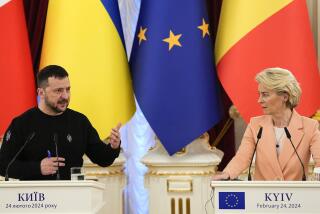Regional Outlook : Move Over London, Paris, Rome: New Cities Want the Spotlight : Central European capitals believe that they are more attuned to the changes taking place on the Continent and that location, history and culture give them an edge.
- Share via
VIENNA — Traditionally, the European capitals recognized as the major centers of political, economic and cultural power were automatically taken to be London, Paris and Rome.
Big Ben still tolls over the Mother of Parliaments, the Eiffel Tower overlooks the City of Light and the Colosseum has not crumbled in the Eternal City.
But nowadays other cities aspire to super-capital status in the new Europe.
Yesterday it was Brussels mushrooming as the center of the European Economic Community; today it is Vienna that wants to be the Gateway to Eastern Europe; and tomorrow, perhaps, it will be a united Berlin demanding recognition as Europe’s powerhouse capital.
But cities like Budapest and Prague, too, are attempting to upgrade their status as something more than national capitals.
Their aspirations are fueled by a changing Europe that is becoming more interdependent--leading to the rise of regional capitals--while at the same time shifting its center of gravity eastward.
Central European capitals believe themselves to be more closely attuned to the rapid and remarkable changes taking place on the Continent--both political and economic--with vast potential markets opening in Eastern Europe from the Baltic to the Adriatic and Black Seas.
These cities plan to take advantage of their geographical and cultural relationships with a Europe that is increasingly coming closer, attracting the former Communist countries into its orbit.
These emerging capitals believe that London, Paris and Rome have been slow to realize the potential of the new political architecture of Europe--an architecture that, whatever final shape it takes, will surely be more canted to the East.
At the same time, the British, French and Italians are belatedly waking up to the fact that they could be somewhat eclipsed in the new Europe.
London, for instance, is making a major pitch for the site of the new International Bank for Eastern Europe. Paris offers itself as the venue for pan-European conferences and is playing political hardball on behalf of Strasbourg to ensure that the European Parliament does not shift to Brussels. Rome and Milan, relying on Italy’s former close ties with Yugoslavia and Austria-Hungary, are sending their salespeople east with their order books.
In short, everyone wants a piece of the new European action.
Unquestionably, the potential of new opportunities among the hundreds of millions of potential customers in Eastern Europe and the Soviet Union is staggering.
And the eventual adhesion of more European countries to the 12-member European Community could make it the most powerful economic force in the world.
Currently, Vienna is perhaps the European city most involved in capitalizing on the shift of balance to the East--and may serve as a prototype for others.
Vienna proudly points to its history as the capital of the Austro-Hungarian Empire, a vast domain that once stretched from the North Sea almost to the Black Sea, its bloodstream the mighty Danube, Western Europe’s longest river.
As the Hapsburg monarchy’s capital, Vienna ruled many peoples, East and West: Germans, Belgians, Dutch, Spaniards, Italians, Hungarians, Croats, Serbs, Poles, Romanians, Slovaks, Slovenes.
The defeat of the Austro-Hungarians in World War II turned Vienna into a provincial Middle European capital. But after decades of slumbering, the city of Mozart, Metternich, the Strausses and Freud has reawakened.
In recent years, Vienna has become an international center with a U.N. complex, the International Atomic Energy Agency, and the long-running meeting of the 35-nation Conference on Security and Cooperation in Europe (CSCE). Today its handsome streets are crowded, its stores a cornucopia of fancy goods, its turn-of-the-century coffee houses restored to operetta elegance and its focus on the East.
According to one estimate, 700 Western firms now cover Eastern Europe from regional offices in Vienna.
The list of new arrivals includes Coca-Cola (Pepsico was already there), Hewlett-Packard, American Express, Bosch, Daimler-Benz, Honeywell and Miele. Dozens of East European firms, too, are locating in Vienna.
“Austria has the advantage of intimacy, mutual affinity and personal contacts developed over decades,” explains William Hedricks, president of an Austrian trade association in Vienna. “East Europeans often prefer to do business with the Austrian branches of foreign firms.”
The new World Trade Center at Vienna Airport will serve as a meeting place for business people from East and West; the city is beefing up flights to Eastern Europe, and high-speed rail lines are planned to bring Budapest in Hungary and Bratislava in Czechoslovakia within commuting distance.
The Austrian capital intends to attract millions of visitors to the six-month-long World’s Fair in 1995, fittingly called “Bridges to the Future,” jointly sponsored by Vienna and Budapest--the first twin-city, world-class exposition ever held.
“There is no city in Europe which has so much to offer the new European order as Vienna,” said Andreas Khol, an executive secretary of the European Democratic Union, a conservative political group.
“This is the historic link between Western and Eastern Europe. We speak the languages, we know the people and we know how they work. We have a key role to play in the making of the new Europe and we intend to make the most of it.”
At the same time, looking westward, Austria has applied for membership in the European Community and hopes to be the next country admitted to that exclusive club. Vienna, then, hopes to repeat the transformation that turned the once-sleepy capital of Belgium into a major European center.
Brussels emerged from obscurity with the basing there of the European Community and the headquarters of the North Atlantic Treaty Organization, both of which increased exponentially in importance over recent years.
Now cranes swing ceaselessly over the gray skyline as the city creates offices for the business people, diplomats and consultants who envisage the capital moving from strength to strength with the coming of the Single Market at the end of 1992.
And Brussels’ role is expected to become even greater as the European Commission, the EC’s executive arm, assumes more power.
In foreign eyes, at least, European Commission President Jacques Delors has a higher political profile in Brussels than Belgian King Baudouin I or Prime Minister Wilfried Martens.
Both Brussels and Vienna look uneasily toward Berlin, which as the capital of a united Germany would be an irresistible magnet for agencies and businesses involved in shaping the new Europe.
“Power attracts,” commented a West German banker recently. “And when Berlin becomes the capital, you will see it attract businesses, agencies and diplomatic missions of all sorts.
“While there are many who think the Germans will retain ministries in Bonn, I believe it is only a matter of time before Berlin becomes the capital--with all that signifies for a nation of 80 million people in the heart of Europe.”
A united Berlin would combine the glitter of the Western sector with the former imperial buildings of the Eastern side into metropolis of 3 million people that could be the most important political, economic and cultural capital in Europe.
In Vienna, residents recall that the old Hapsburg emblem has particular significance today. It was the famed Double Eagle, a symbol dating from the Roman Emperor Constantine who divided the realm between Rome and Constantinople. One head of the eagle gazed fiercely eastward, the other to the west.
The Double Eagle’s modern equivalent, the Viennese say, has one eye on the European Community and the other on the emerging states of the fallen Communist empire.
The Emerging Capitals of Europe
Berlin (united) Population: 3.2 million Area: 341 square miles Population density: 9,384 persons per square mile Year founded: 1244
Brussles Population: 1 million Area: 62 square miles Population density: 15,806 persons per square mile Year founded: 1312
Budapest Population: 2.1 million Area: 203 square miles Population density: 10,364 persons per square mile Year founded: 1872
Prague Population: 1.2 million Area: 192 square miles Population density: 6,158 persons per square mile Year founded: 1230
Vienna Population: 1.5 million Area: 160 square miles Population density: 9,262 persons per square mile Year founded: 1221
More to Read
Sign up for Essential California
The most important California stories and recommendations in your inbox every morning.
You may occasionally receive promotional content from the Los Angeles Times.









